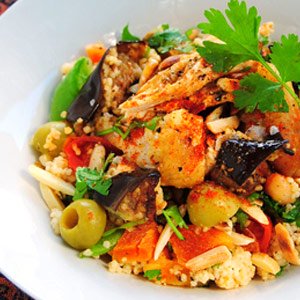North African chicken and couscous salad
8 servings
Prep: 20 mins,
Cooking: 2 hrs
Here's a bountiful salad crammed with interesting textures and the sunny, spicy flavours of North Africa.
Rate this recipe
Recipe Disclaimer
Tap for method
Ingredients (43)
For the chicken and stock:
| 1 | chicken — trimmed |
| salt | |
| 1 | carrots — peeled, roughly chopped |
| 1 | celery stalks — sliced |
| 6 | fresh parsley |
| 10 | black peppercorns |
| 2 | bay leaves |
| 3 | cloves — whole |
| 1 | onion — quartered |
| water | |
| 1/2 | lemon |
| 2 | garlic — cloves, peeled |
For the spice paste:
| 15 ml | cumin — seeds |
| 10 ml | coriander — seeds |
| 5 ml | sea salt — flaky |
| 5 ml | black peppercorns — whole |
| 4 | garlic — cloves, peeled |
| 1 | red chilli — chopped |
| lemon — zest only | |
| 7.5 ml | cinnamon — ground |
| 90 ml | fresh chillies — 573 |
For the salad:
| 2 | aubergine |
| olive oil | |
| salt | |
| 600 g | cherry tomatoes |
| 500 g | couscous — cooked |
| 1 | sugar snap peas — sliced |
| 12 | apricots — Turkish, chopped |
| 250 ml | olives — green, pitted |
| 1 | chickpeas — tinned |
| fresh coriander — bunch | |
| fresh parsley |
For the dressing:
| lemon — juice only | |
| orange — juice only | |
| 7.5 ml | cumin — ground |
| 7.5 ml | paprika — sweet |
| 2.5 ml | chilli powder — to taste |
| 10 ml | dried mint |
| 5 ml | lemon — zest only |
| cinnamon — ground |
To top:
| fresh parsley — and coriander | |
| 100 g | almonds — flaked, toasted |
| cumin |
Tap for ingredients














